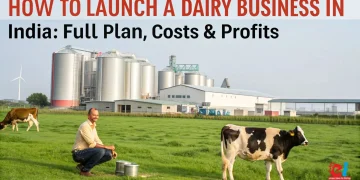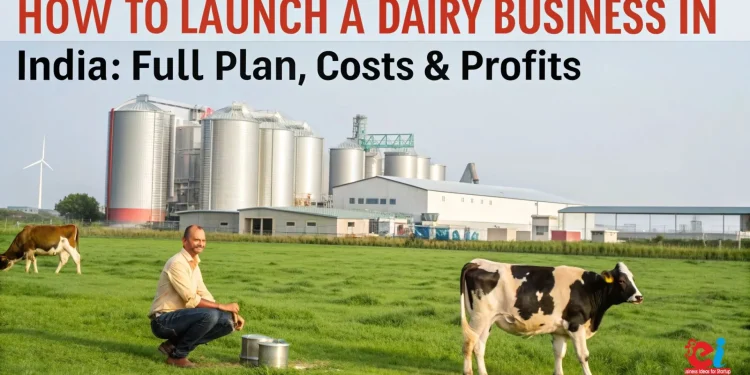The dairy business in India is witnessing a shift since it is anticipated to improve from its traditional origin in agribusiness to a structured opportunity, in other words, to a flourishing industry. Its changing into an enterprise that is self sustainable admired by strong consumer demand, supportive state policies, and awareness regarding hygiene in milk consumption is on a constant rise.
The unpredicted transformations occurring in production, distribution, and consumption of dairy products has pushed India at the forefront as the highest milk producing nation across the globe. With increased interest from both rural and urban populations regions as an occupation and a commercial venture alongside supported by startups, this industry proves to be profitable. This competitive industry however does require a detailed business strategy covering everything from breed choices, infrastructure, feed, milk processing, by-product utilization, financial planning down to marketing strategies.
Dairy Business in India
The Indian Dairy Business is estimated at over ₹13 lakh crore and makes more than 4% of the GDP. The growth in population and increasing income levels are leading to a surge in the consumption of milk as well as its products such as paneer, ghee, yogurt, and cheese. Urban consumers are increasingly concerned with the purity, freshness, and ethical sourcing of milk which is along with the precise farming done pushing the demand for organic milk, fresh farm milk, and value-added foods. This concern can be transformed into a brilliant chance to develop differentiated dairy brands tailored directly at niche markets.
However, due to a lack of scientific herd management, inadequate nutrition, and ill-controlled diseases, India’s dairy productivity per animal stands lower than developing nations. This leaves opportunity for the next generation of dairy entrepreneurs also referred to as dairypreneurs to come into the industry using advanced feeding techniques and digital herd monitoring, as well as cold chain integration. Schemes like Dairy Processing and Infrastructure Development Fund (DIDF), Rashtriya Gokul Mission, and NABARD subsidies form governmental support which further strengthens the business model of Dairy Business, making it sustainable and bankable.
Selecting an Appropriate Breed: The Beginning of Productivity
The selection of a dairy business must align with the farmer’s goals to ensure the success of the dairy business. Farmers have to choose from indigenous breeds like Gir, Sahiwal, and Rathi that are well-adjusted to the Indian climate or exotic breeds Holstein Friesian and Jersey that are known for their high utter market. Commercial farms also prefer crossbreds like HF-Sahiwal which are moderately adaptable to climate and highly productive.
When cows are provided with good feed and care, the high yielding breeds can produce between twenty to thirty liters of milk per day. Buffaloes like Murrah and Mehsana are also popular due to their high-fat content milk which is ideal for ghee and paneer production. Different breeds have to be chosen according to the region’s climate, available food, available veterinary services, and the most preferred type of milk in the market (cow or buffalo milk). Entrepreneurs must also assess the breeding cycle, access to artificial insemination, and lactation period prior to forming the herd composition.
NIIR Project Consultancy Services (NPCS) offers specific cattle dairy project reports covering everything from projecting milk yield, breeding schemes, and calf husbandry, to herd health policies, providing investors with a scientific basis for productivity and herd management.
Related: Profitable Dairy Farming: A Lucrative Startup Opportunity
Layout Planning of Farms and Their Infrastructural Needs
In any commercial dairy farm, effective infrastructure is vital not only for the wellbeing of the animals but also for operational effectiveness. A good layout reduces occurrence of diseases, infection during milking, enhances worker productivity, and most importantly, upholds a high level of hygiene. Every animal should have a shelter, feeding area, resting area, clean drinking, and medically treated water, while all animals should have easy access to these facilities. In addition, sheds are supposed to be well ventilated, bear drainage slopes, have the capacity to let in advantageous sunlight during the day, and block rain, snow, and extreme temperatures.
Farms usually incorporate an individual area for milking parlors, dry cows, calves, feed storage, silage pits, and even compost units. It is ideal to separate the milking area from the feeding zones as well as dung disposal areas to ensure that biosecurity is efficiently offered. To lower costs of fodder cultivation, it is recommended that built-up land of 1 to 1.5 acres along with 2-3 acres for cultivating fodder is allocated for 50 to 100 animals. To curb reliance on labor, medium and large scale farms prefer the automation of milking, feeding, and waste removal services.
NPCS assists entrepreneurs in all stages of construction and development of a custom designed layout to their specific needs considering the size of the herd, degree of automation, and budget drawn. These custom designs also include architectural design, barn engineering, drainage, and green infrastructural elements such as solar pumps and units to collect water from the rain.
Milk Yield Feed and Nutrition Management
Nutrition impacts milk quantity as well as an animal’s health, and reproductive efficiency. It is observed that in every dairy operation, feeding related costs takes a major chunk- around 60% of all costs. An adequate diet including green fodder, dry fodder and concentrate assures maximum yield of milk. Concentrated feed made of proteins, minerals and vitamin supplements is essential to ensure energy during peak lactation periods. All these factors greatly aid in milk yield.
Farmers are increasingly cultivating their own fodder or setting up silage units for fortifying off-season green feed supply. Off-season green feed supply helps cows bred crossbreed type. On the farms, troughs rationed to deal with total mixed ration TMR systems have been installed. Block feeding systems help in regulating feed intake, preventing selection, and reduce wastage. Entrepreneurs are in charge of procuring feed and controlling conditions under which the feed is stored and wastage is monitored. Management of nutrition cycles and fodder cultivation also requires devolvement of land estimating mechanisms.
NPCS aid their clients with project reports where feed conversion models and yearly calendars nutrition are provided.
Collection, Chilling and Milk Production
Hygienic milking and swift chilling of the milk is a fundamental step in the dairy value chain. Milking can either be done by hand, or using automatic milking machines that offer better speed, hygiene, and consistency. After milking, the milk should be skimmed, graded for cream and SNF (Solids-Not-Fat), and either stored in stainless steel containers or directly refrigerated using Bulk Milk Coolers (BMCs). It is crucial that the milk is cooled to 4°C within two hours, to control the rate of bacterial activity and spoilage.
For India, given the tropical climate, the cold chain infrastructure becomes important in the transportation of the milk to collection centers, processing units, and retail outlets. BMCs, chillers, and insulated tankers are expensive but essential in maintaining the quality of milk. The conversion of milk into ghee, paneer, curd, and cheese not only adds value to the product, but also increases shelf-life and profitability. There is higher competition for processed dairy products over raw milk in urban and export markets.
NPCS helps clients set up the complete milk processing setup that includes machine layout, BMC, pasteurization, packaging, and FSSAI and BIS mark requirements.
Waste Management, Biogas, and Sustainability
A dairy business with 100 cows produces about 2-3 tonnes of cow dung daily. If not properly handled, this poses a serious health and environmental challenge. On the other hand, when handled properly, it presents a great business opportunity. Manure can be composted and sold to organic farmers or it can be utilized to produce biogas. Dung is converted to methane gas in biogas plants and is used for cooking, electricity, or even in farm engines. The slurry by-product is a nutrient-rich fertilizer ideally suited for organic farming.
Farms can drastically cut down on energy costs and gain income through carbon credits with the setup of a small biogas unit on the farm. Other features of sustainable dairy business include capturing solar energy for lighting, rainwater harvesting, as well as drip irrigation for planting fodder which help in offsetting operational costs and aid in eco-compliance.
NPCS offers complete support for integrating sustainability into dairy operations. We develop project reports for biogas plants, compost units, as well as assist with organic certification..
Related: Value-Added Products of the Dairy Processing Industry
Sales and Marketing Strategy
The selling of milk and dairy products has come a long way from local milkmen or cooperatives. Today’s entrepreneurs in dairy can establish a farm-to-home delivery model, provide to restaurants and hotels, sell through refrigerated retail outlets, or even look into exporting dairy products. Consumers are ready to spend high amounts of money for organic A2 cow milk, antibiotic-free dairy products, and artisan ghee produced through Bilona churning techniques. Branding and packaging significantly impact B2C selling where cleanliness, traceability, and the story behind the origin are crucial.
A good strategy will create a local customer base through social media, implement subscription services, and partner with aggregators such as BigBasket, Amazon Fresh, or even organic retailers. Direct sales to schools, hospitals, and private corporate canteens also provide steady income. Marketing should focus on the differentiating attribute of the product, be it the breed of cows used for milk, ghee with herbal fusion, or probiotic curd.
NIIR Project Consultancy Services provides consultancy services for brand strategy formulation, packaging design, and setting up marketing channels which are part of the extended services offered.
How NPCS Assists in Starting a Dairy Business with a Confidence Boost
NPCS customizes project plans and offers step-by-step counseling on setting up commercial ghee, milk, methane, and dairy farming facilities for co-operative societies and agri-tech start-ups. NPCS service enables you to:
- Get complete assistance with plant layout and selection of breeds to milk chilling and packaging units.
- Get comprehensive detailed project reports (DPRs).
- Get assistance with financial planning, market entry strategies, and investor decks for easy loan approval from banks.
- Get support in obtaining FSSAI, MSME, Pollution Control, and Animal Husbandry Department NOCs.
NPCS assures that the dreams of dairy Business transforms into a real business model that generates revenue.
Final Thoughts
With the right strategy, any entrepreneur can create a reliable revenue model for themselves and take advantage of the NPCS services.
The scope for branding, expansion, and assets goes beyond being just a rural occupation. With advanced technological approaches and stringent disciplined management, developing reliable cattle brands that can thrive in both, domestic and international markets backed by enduring demand is completely possible.Whether you are beginning with 20 cows or forming a vertically integrated dairy business, remember that success stems from smart planning, sharp execution, and setting a clear intent. With NPCS, you receive industry insights, feasibility studies, operational plans, and other analytics that help in splashing your investments with enduring returns throughout your dairy business ventures.


























